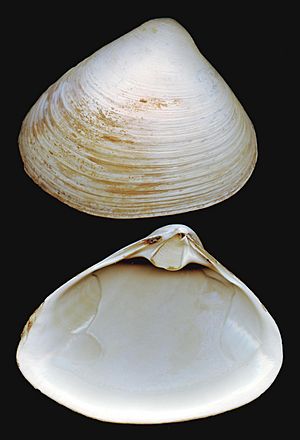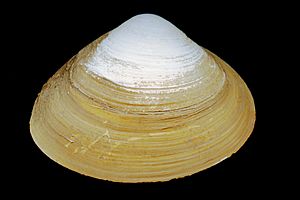Atlantic surf clam facts for kids
Quick facts for kids Atlantic surf clam |
|
|---|---|
 |
|
| A 15 cm adult shell of Spisula solidissima from Long Beach, Long Island, New York State. Right valve at the top, left valve at the bottom. | |
| Scientific classification |
The Atlantic surf clam (Spisula solidissima) is a very large clam that lives in the ocean. People also call it the bar clam, hen clam, skimmer, or just sea clam. It's a type of bivalve mollusk, which means it has two shells that hinge together.
These clams are found in the western Atlantic Ocean. They can grow very big, sometimes over 20 centimeters (about 8 inches) long! Their shells are a common sight on beaches in the northeastern United States. Beach-goers often pick up their large, empty shells. They might use them to dig in the sand or take them home as a decoration.
Atlantic surf clams are also caught and sold as food.
Contents
Where Do Atlantic Surf Clams Live?
This common clam lives along the east coast of North America. You can find them from Nova Scotia in Canada all the way down to South Carolina in the U.S.
They have also been introduced to Hokkaidō, a northern part of Japan, where they are farmed.
Their Home Environment
Atlantic surf clams like to bury themselves in sand. They live both far offshore and closer to the coast. You can find them in the intertidal areas, which are covered by water at high tide and exposed at low tide. They also live in the surf zone, where waves break.
How Do Atlantic Surf Clams Live?
These clams grow at different speeds depending on where they live. Off the coast of New Jersey, they can become adults in just three months. But off Nova Scotia, it can take up to four years. Atlantic surf clams can live for a long time, sometimes up to 31 years!
What Do They Eat?
Like most clams, Atlantic surf clams are filter feeders. This means they use special tubes called siphons to pull in seawater. They then filter out tiny bits of food from the water. Their diet includes small pieces of organic matter and tiny sea creatures called plankton.
How Do People Use Atlantic Surf Clams?
Atlantic surf clams are an important seafood. People have enjoyed their sweet taste for a long time.
Harvesting Clams
These clams are usually caught by special fishing boats called dredgers. These boats use a unique fishing dredge tool. This tool has powerful water jets that loosen the clams from the sand. Then, it scoops them up.
Clam Meat and Products
About two-thirds of a surf clam's meat can be eaten. The meat is used in different ways, like 'strips', chowder, and sushi.
The "tongue" or foot of the clam is very popular. It is cut into long strips, breaded, and then fried. These are known as clam strips. The Howard Johnson's restaurant chain helped make them famous.
Any meat left over after making strips is called "salvage" in the clam industry. This includes the adductor muscles. These are the strong muscles that hold the clam's two shells tightly shut. "Salvage" meat is often ground up and used in chowders, sauces, and dips. You can buy it in cans or frozen. Sometimes, it's available fresh locally.
Some fishermen also use the large "belly" part of the clam as bait. They use it to catch fish like striped bass.
- The Long Island Shell Club, 1988. Seashells of Long Island, Long Island Shell Club Inc, New York State.


